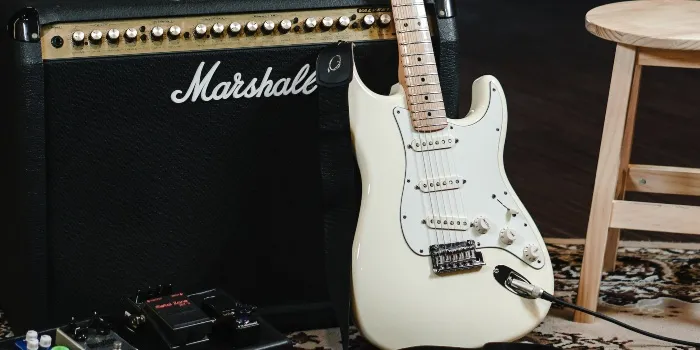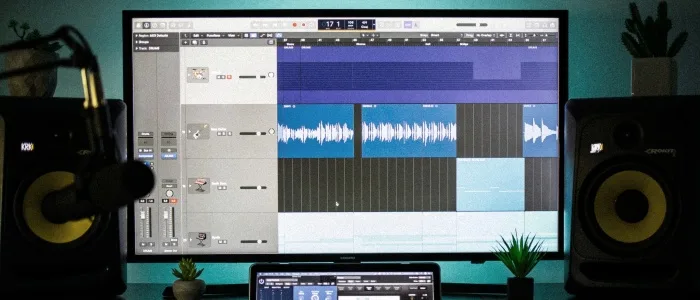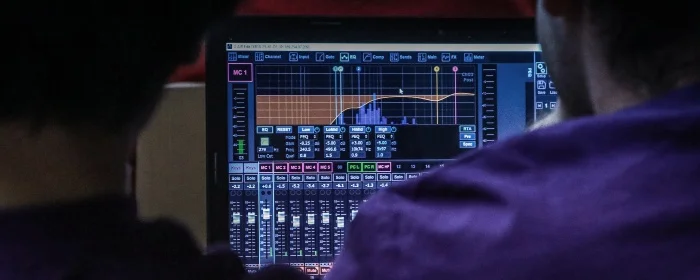Double tracking guitars is the process of recording the same guitar part twice, with two different guitar tones.
It’s a popular recording method in any music genre, especially in metal and it’s a simple yet effective way to add depth and texture to your guitar tracks.
The sound of a double-tracked guitar can be an invaluable tool in any recording setup, providing the opportunity to thicken and add character to guitar tracks.
Let’s dive in and learn how to double-track guitars and prepare them for mixing.
1. Create Two Different Guitar Tones

To properly double-track guitars, you must create two different guitar tones and record them separately.
Many beginners make a mistake when they record once and then copy the track. That’s not the way double tracking works for electric guitars.
You must always record the same part twice with different tones. However, these guitar tones must sound good together.
And to create two unique guitar tones, you have various options:
- Use different guitars
- Use different amps
- Record with different microphones
For example, if you use a single-coil guitar for the first tone, use a humbucker guitar for the second one.
Or use a different amp or speaker for each guitar. And if you use microphones to record your guitars, use different mics or mic combinations for each guitar.
The goal is to have two tones with unique characteristics. So, one guitar could have more mid-range than the other and the second one could have more highs than the first one.
But when you play two tones together, they must sound good and sit well in the mix.
2. Record & Pan Guitars

After you create good-sounding and unique guitar tones, it’s time to record both parts separately.
Create a track for the first guitar and record the whole part. Then create another track and record the same guitar part with the second guitar tone.
This way, you will have two guitar tracks with the same part but with different sounds.
For more information, read my guide about recording electric guitars.
And then you need to pan guitars on both sides which will give guitar tracks a stereo width and they will sound huge.
Panning is a popular method of modern recording and every song uses it for various instruments and tracks.
Guitar panning is a must for almost every song, especially in heavy music because without it, your guitar tracks won’t sound good and powerful.
And it’s very simple to pan guitars in the mix. Just take the first guitar and pan it on the left side by 100% and pan the second guitar on the right side.
So, you will hear the first guitar in the left speaker and the second guitar in the right speaker.
This way you create a stereo sound for guitars and also it creates the space for other tracks to live in the center.
3. Apply Cosmetic EQing

Now, you need to apply EQ to both guitar tracks separately but you don’t need to do full EQing.
The full mixing for the guitar starts later. For now, you just need to apply cosmetic EQ to remove excessive frequencies in very low and high ranges.
And to remove unnecessary frequencies from each guitar track, you need to use EQ filters – high pass and low pass filters.
Use HPF to remove low frequencies and LPF to remove excessive high frequencies. Do this for both guitars separately.
And remember that you don’t need to do hard EQing. Don’t cut too many frequencies because you will do the proper EQing for guitars later.
This will get rid of unnecessary frequencies and both guitar tones will become a little bit cleaner which will make the mixing process easier.
4. Send Guitars To A Bus Track
And finally, you need to create a bus track for the guitar and send both guitar tracks to that bust track.
This is essential because you treat it like one guitar and that’s very helpful in mixing.
This way there is more chance to avoid mixing mistakes and simply, it’s easier to mix guitars with only one track.
So, create a bus track and send both signals to it. Now, both guitar signal goes to a bus track, and then it goes to the master track.
It becomes your main guitar track and you can add EQ and other plugins to do regular mixing.
FAQ: Double Tracking Guitars
Here are some of the most frequently asked questions about how to double-track guitars.
Should You Always Double Track Guitars?
In most cases, you should use a double-tracking method for guitars, especially for metal. But there might be cases where you don’t have to use it and only one guitar track is enough.
Should You Double Track Lead Guitar?
Double-tracking a guitar solo is not as common as rhythm guitars but some guitarists such as Randy Roads and John 5 use it to create unique-sounding lead tones.
What Instruments Require Double Tracking?
The guitar is the most popular instrument to double track but double tracking is very common for vocals. Especially for choruses because it creates powerful and huge sounds and helps the chorus to cut in the mix better.
Conclusion
Double-tracking electric guitars is a very common way to create huge guitar sounds and stereo width in the mix. It can be used in any song or music style and adds depth, power, and character to the sound. Guitar double tracking is very popular in metal and also the method works with vocals.
